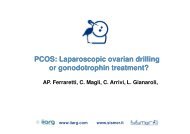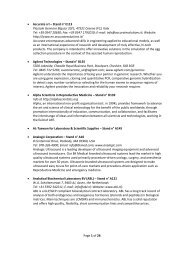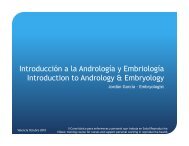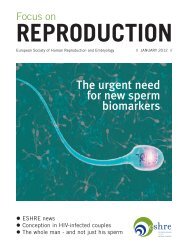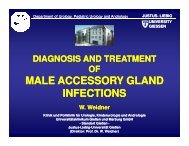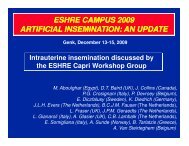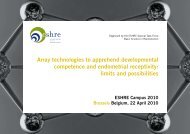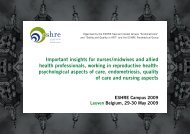Ovarian Hyperstimulation Syndrome - eshre
Ovarian Hyperstimulation Syndrome - eshre
Ovarian Hyperstimulation Syndrome - eshre
Create successful ePaper yourself
Turn your PDF publications into a flip-book with our unique Google optimized e-Paper software.
2.3 Primary risk factorsPolycystic ovarian syndrome (PCOS)Patients with some characteristics of PCOS:o High number of follicles in both ovaries at the quiescent state beforestimulation (≥10 follicles of 4-10mm in each ovary).o LH/FSH ratio >2.o HyperandrogenismHistory of OHSSYoung patientsLean womenAllergic predisposition2.4 Secondary risk factors Maximum serumestradiol >3000-4000 pg/ml.o No clear cut-off valueo Relatively poor predictive power (max. 73%).o Oestradiol itself is no mediator since OHSS is also possible withlow serum oestradiol values (stimulation with recFSH)o The slope of the oestradiol rise is the main risk factor and is of moreimportance than the maximum level (PPV 77%). Number of follicles per ovary >20-25.o No clear cut-off value (10-35).o Variation dependent upon operator and technique. Measurements of the absolute VEGF (vascular endothelial growth factor)-serum concentration are not useful for individual prediction (Mathur et al.,2002).2.3 PhysiopathologyThe physiopathology of the OHSS is increasingly better understood. The crux is anequilibrium between pro-angiogenic and anti-angiogenic factors present in follicular fluid.The pro-angiogenic role of the vascular endothelial growth factor (VEGF) is an importantmediator of the syndrome (Pellicer et al., 1999; Garcia-Velasco and Pellicer, 2003). Highconcentrations of VEGF have been demonstrated in follicular fluid, making the mediating roleof ovarian VEGF in the development of OHSS very plausible. VEGF concentrations in asciticfluid, serum and plasma concentrations in OHSS patients were shown to be increased(McClure et al., 1994; Abramov et al., 1997; Agrawal et al., 1999). mRNA expression ofVEGF in human luteinized granulosa cells is time- and dose dependent of HCG furtherunderlining the role of VEGF in the development of the OHSS (Neulen et al. 1995, 1998).Later it was shown that two VEGF-receptors exist (VEGFR-1 en VEGFR-2), both producedby endothelial cells, of which one exists in a soluble form, s(serum)VEGFR-1, acting as anegative modulator of the bioactivity of VEGF.Excess of bioactive pro-angiogenic VEGF increases the risk for OHSS; excess of antiangiogenicsVEGFR-1 (and other anti-angiogenic factors) decreases the ovarian response andthe risk for OHSS and is accompanied by a decreased pregnancy rate (Pellicer et al., 1999).Absolute serum concentrations have no value in the individual risk assessment because there4




